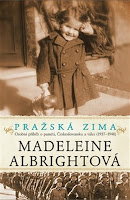 Madeline Albright was the first female U.S. Secretary of State. Due to the -ova thing, over here she is Madeline Albrightová. She is well respected in Czechland and not just because she was born in Czechoslovakia and that she speaks Czech.
Madeline Albright was the first female U.S. Secretary of State. Due to the -ova thing, over here she is Madeline Albrightová. She is well respected in Czechland and not just because she was born in Czechoslovakia and that she speaks Czech.She was born Marie Jana Korbelová in Prague in 1937. Her father was a diplomat during the First Republic serving at the embassy in Belgrade. When Nazi Germany took the Sudentenland, the family went to the UK where her father worked for the Czechoslovak government-in-exile.
In 1941, the family converted from Judaism to Catholicism in order to protect themselves from the Nazis. Her parents never told her or her siblings about their Jewish ancestry.
 After the war, the family returned to Prague before eventually moving to Belgrade when her father was appointed as the country's ambassador to Yugoslavia. Her father was opposed to communism so when the communists took over in 1948 the family emigrated to the USA. She became an American citizen in 1957. Later she earned her PhD with her doctoral dissertation on the role of journalists during the 1968 Prague Spring.
After the war, the family returned to Prague before eventually moving to Belgrade when her father was appointed as the country's ambassador to Yugoslavia. Her father was opposed to communism so when the communists took over in 1948 the family emigrated to the USA. She became an American citizen in 1957. Later she earned her PhD with her doctoral dissertation on the role of journalists during the 1968 Prague Spring.In 1992, following President Clinton's election win, she helped assemble the National Security Council. From 1993 to 1997 she was the U.S. Ambassador to the United Nations. From 1997 to 2001 she served as Secretary of State.
 |
| Madeline Albright and Václav Havel |
During her time at State, she was a champion for expanding NATO to Central and Eastern Europe. In 2012 she received the U.S. Presidential Medal of Freedom and a few weeks ago the Czech government awarded her the Medal of Merit Award for Diplomacy.
Here's a 5-minute video I found out on YouTube about her early career.
©Makers
Update: Madeleine Albright passed away in 2022.







































